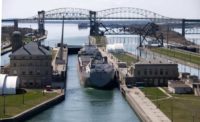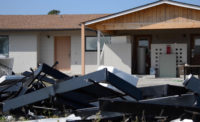Infrastructure
Trump Signs Water Infrastructure Bill Providing $3.7B for New Corps Projects
A new water infrastructure bill has become law, authorizing $3.7 billion for a dozen new Army Corps of Engineers projects and $4.4 billion for drinking-water projects, but funds are subject to annual appropriations.
President Trump signed the measure, the America’s Water Infrastructure Act, on Oct. 23 at the White House as lawmakers who played roles in crafting the bipartisan bill looked on.
The legislation is the second important federal infrastructure bill to become law in less than three weeks. It follows a five-year Federal Aviation Administration bill, which Trump signed on Oct. 5.
That new law authorizes $16.8 billion over five years for FAA’s long-established Airport Improvement Program construction grants, which amounts to a freeze at previous levels. It also has $5.3 billion for a new discretionary airport infrastructure grant program.
But the water bill, like the FAA legislation, has a significant catch—its authorizations still require yearly appropriations installments for the projects to be constructed.
The newly authorized Corps projects next will compete for limited appropriation dollars with many other authorized but not-yet-started projects.
Still, the water measure’s enactment was greeted with praise. Trump called it “another major step” toward his goal of “a great rebuilding of America’s infrastructure.”
Trump also noted that two key Senate Democrats, Tom Carper of Delaware and Ben Cardin of Maryland, were present at the of the signing. And he said, “I have a feeling that…we’re going to do a lot of infrastructure together.”
The core of the bill is its Water Resources Development Act (WRDA) title, which covers the Corps projects and policy provisions.
With the measure’s enactment, Congress again hit its recent target of passing WRDA bills every two years. It follows WRDAs that became law in 2014 and 2016.
The new statute goes beyond the Corps to include provisions dealing with drinking-water infrastructure. As the American Water Works Association (AWWA) noted, the bill reauthorizes the Environmental Protection Agency’s drinking-water state revolving loan fund program for the first time since 2003.
The group says the new statute also doubles the drinking-water authorization, to $1.95 billion, in the new law’s third year.
AWWA also was pleased to see language authorizing EPA’s Water Infrastructure Finance and Innovation Act (WIFIA) loan program at $50 million a year for two years and removes it from pilot program status.
AWWA CEO David LaFrance said in a statement that the WIFIA provisions represent “a significant milestone for the program and a great victory for the entire water sector.”
Senate Environment and Public Works Committee Chairman John Barrasso (R-Wyo.), a prime author of the bill, said, “This is good for our communities, it’s good for the country. It’s good for the economy as well as good for the environment.”
The Senate cleared the popular bill on Oct. 10 by a 99-1 vote. The House passed it on Sept. 13 by a voice vote.
Carper, the top Democrat on Environment and Public Works, said, “This legislation goes a long ways towards…furthering a partnership between the state and federal government to provide clean drinking water….”



